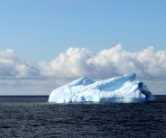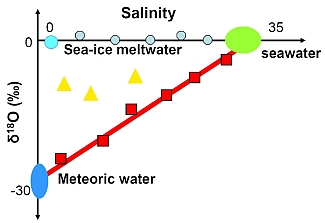δ18O
The Weddell Gyre is an area of known importance in the global climate system as it is the prime site for the formation and export of deep and bottom waters around Antarctica, and is also a region of significant freshwater export (e.g. Orsi et al., 1993). The role of freshwater here is paramount: at low temperatures, density depends almost entirely upon salinity, so stratification, circulation and deep water formation all depend critically on the freshwater balance (Gill, 1973).
δ18O is a tracer of very great utility in high latitude freshwater studies, since it enables quantification of freshwater from separate sources. Specifically, when measured alongside salinity, δ18O allows the determination of inputs of freshwater from meteoric sources (glacial ice melt, precipitation) separately from those due to oceanic sources (sea ice melt) (e.g. Weiss et al., 1979; Meredith et al., 2007). Such partitioning is needed since these separate components will vary differently on seasonal, interannual and longer timescales, and to fully understand the nature and impact of the changing freshwater budget of the Weddell Gyre, we need to understand how its individual components vary.
Click to enlarge and for additional details.
Measurements of the stable isotopes of oxygen (δ18O) in seawater will be combined with salinity and velocity fields in order to quantify for the first time the individual exports of different forms of freshwater (sea ice melt, precipitation and glacial melt) from the Gyre into the global oceanic thermohaline circulation (THC). Comparison with sparse historical data http://data.giss.nasa.gov/o18data/) will reveal any changes in the freshwater composition of individual water masses, and place our measurements in the context of interannual and decadal change. The implications for controls on ocean circulation and climate against a background of a changing hydrological cycle will be assessed.
REFERENCES:
CIOWG - Canadian Arctic Archipelago mooring (Lancaster Sound) and numerical modelling program, 2005, retrieved October 05, 2009 from Fisheries and Oceans Canada - Oceans and Ecosystem Science - http://tinyurl.com/y9t4bfb
Gill, A.E., Deep-Sea Research, 20, 111-140, 1973.
Meredith, M.P., et al. "Variability in the freshwater balance of northern Marguerite Bay, Antarctic Peninsula: Results from δ18O", Deep-Sea Research II, 55, 309-322, 2008.
Orsi, A.H., W.D. Nowlin and T. Whitworth. "On the circulation and stratification of the Weddell Gyre", Deep-Sea Research I, 40, 1, 169-203, 1993.
Weiss, R.F., et al., "Geochemical studies of the Weddell Sea", Deep-Sea Research , 26, 1093-1120, 1979.











